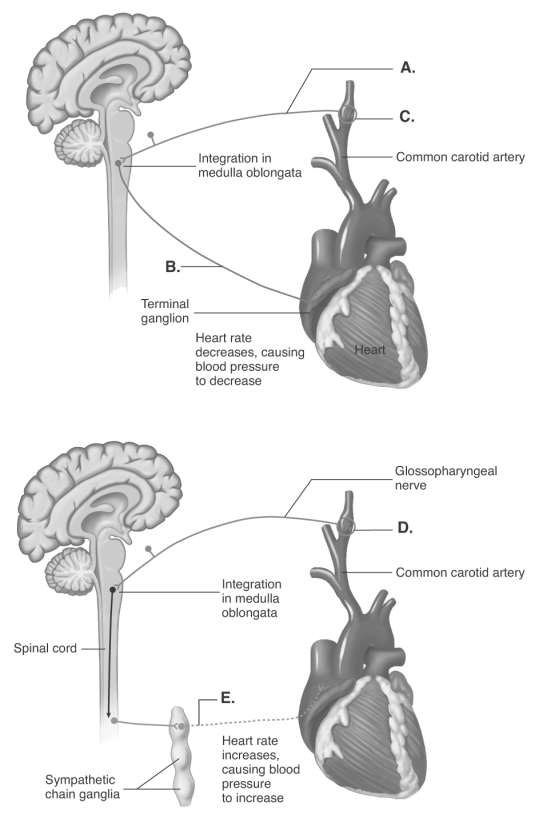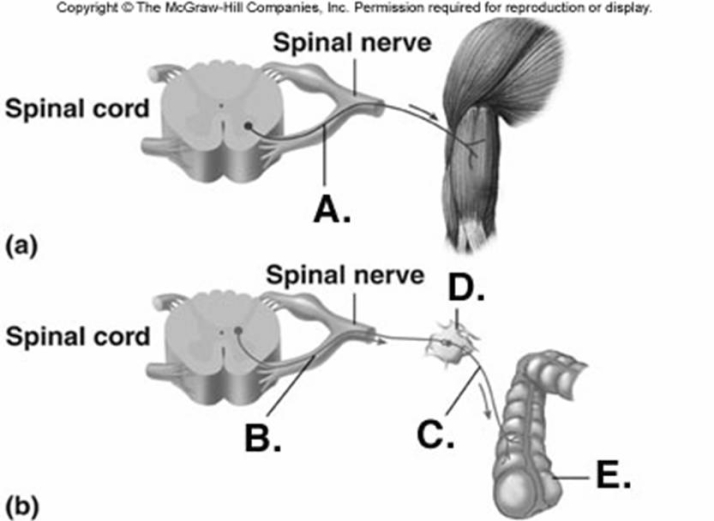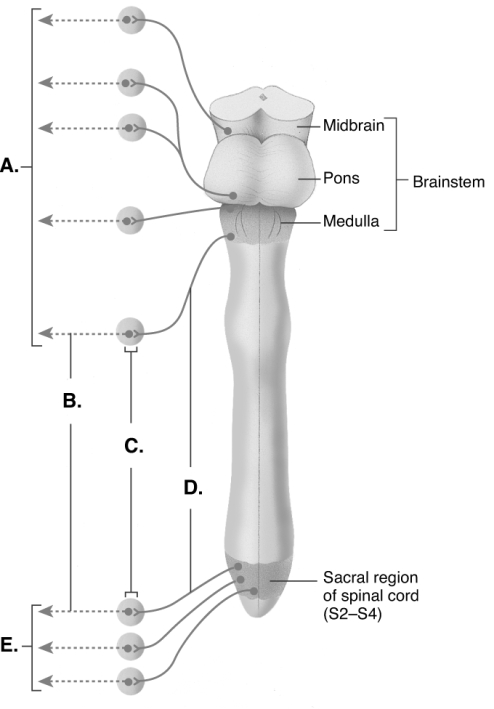A) constriction of the pupils of the eyes
B) constriction of the bronchioles in the lungs
C) contraction of the urinary bladder
D) increased heart rate
E) increased gastric secretions
G) A) and C)
Correct Answer

verified
Correct Answer
verified
Multiple Choice
Match the characteristic with the correct nervous system. -all axons are myelinated
A) somatic motor nervous system
B) autonomic nervous system
C) both somatic and autonomic nervous systems
D) neither somatic nor autonomic nervous system
F) A) and D)
Correct Answer

verified
Correct Answer
verified
Multiple Choice
Which of the following is NOT a symapthetic effect on the body?
A) increased coagulation
B) relaxation of ciliary muscle for far vision
C) constriction of the pupil
D) decreased insulin secretion
F) C) and D)
Correct Answer

verified
Correct Answer
verified
Multiple Choice
 -The figure illustrates the autonomic reflexes and the heart. What does "B" represent?
-The figure illustrates the autonomic reflexes and the heart. What does "B" represent?
A) sympathetic nerve
B) increase in blood pressure detected by carotid baroreceptors
C) glossopharyngeal nerve
D) decrease in blood pressure detected by carotid baroreceptors
E) vagus nerve
G) None of the above
Correct Answer

verified
Correct Answer
verified
Multiple Choice
The short connection between a spinal nerve and a sympathetic chain ganglion through which preganglionic neurons pass is called the
A) white ramus communicans.
B) gray ramus communicans.
C) splanchnic nerve.
D) terminal ganglia.
E) pink ramus communicans.
G) C) and D)
Correct Answer

verified
Correct Answer
verified
True/False
Sympathetic effects are always stimulatory, while parasympathetic effects are always inhibitory.
B) False
Correct Answer

verified
Correct Answer
verified
Multiple Choice
The two classes of adrenergic receptors are
A) alpha and beta.
B) splanchnic and terminal.
C) muscarinic and nicotinic.
D) nicotinic and cholinergic.
E) muscarinic and terminal.
G) B) and E)
Correct Answer

verified
Correct Answer
verified
Multiple Choice
Which of the following is NOT an effector controlled by the autonomic nervous system?
A) cardiac muscle
B) glands
C) skeletal muscle
D) smooth muscle in blood vessels
E) smooth muscle in the digestive system
G) B) and D)
Correct Answer

verified
Correct Answer
verified
Multiple Choice
Effector cells that respond to acetylcholine released from postganglionic neurons have
A) somatotrophic receptors.
B) muscarinic receptors.
C) adrenergic receptors.
D) nicotinic receptors.
E) macrotinic receptors.
G) A) and E)
Correct Answer

verified
Correct Answer
verified
Multiple Choice
 -Identify structure "C" on the bottom diagram.
-Identify structure "C" on the bottom diagram.
A) autonomic ganglion
B) somatic motor neuron
C) effector organ (smooth muscle of GI tract)
D) postganglionic neuron
E) preganglionic neuron
G) A) and B)
Correct Answer

verified
Correct Answer
verified
Multiple Choice
The two divisions of the ANS have antagonistic effects on each of the following EXCEPT
A) the diameter of the blood vessels in skeletal muscles
B) the diameter of bronchioles in the lungs
C) gastrointestinal peristalsis
D) heart rate
E) the eye
G) A) and C)
Correct Answer

verified
Correct Answer
verified
Short Answer
A neuron that secretes norepinephrine would be a(n) _________ neuron.
Correct Answer

verified
Correct Answer
verified
Multiple Choice
Match the characteristic with the correct nervous system. -target tissues may be stimulated or inhibited
A) somatic motor nervous system
B) autonomic nervous system
C) both somatic and autonomic nervous systems
D) neither somatic nor autonomic nervous system
F) B) and C)
Correct Answer

verified
Correct Answer
verified
Multiple Choice
Beta-blockers (beta-adrenergic blocking agents) are frequently used to
A) cause vasoconstriction.
B) block muscarinic receptors.
C) dilate the pupils of the eye.
D) prevent increases in heart rate.
E) prevent decreases in heart rate.
G) A) and C)
Correct Answer

verified
Correct Answer
verified
Multiple Choice
Match the phrase to either the sympathetic or parasympathetic division of the autonomic nervous system. -effects are short-lived
A) sympathetic
B) parasympathetic
D) undefined
Correct Answer

verified
Correct Answer
verified
Multiple Choice
 -The figure illustrates the parasympathetic division. What does "D" represent?
-The figure illustrates the parasympathetic division. What does "D" represent?
A) preganglionic neurons
B) pelvic splanchnic nerves
C) cranial nerves
D) postganglionic neurons
E) terminal ganglia
G) C) and D)
Correct Answer

verified
Correct Answer
verified
Multiple Choice
Match the phrase to either the sympathetic or parasympathetic division of the autonomic nervous system. -effects are more general
A) sympathetic
B) parasympathetic
D) undefined
Correct Answer

verified
Correct Answer
verified
Multiple Choice
John sees Martha; the pupils of his eyes dilate. It is "love at first sight." What division(s) of the ANS is(are) involved?
A) sympathetic division
B) parasympathetic division
C) somatic motor division
D) neither sympathetic division nor parasympathetic division
E) both sympathetic division and parasympathetic division
G) B) and C)
Correct Answer

verified
Correct Answer
verified
Multiple Choice
Efferent neurons of the
A) somatic motor nerves innervate smooth muscle.
B) ANS innervate skeletal muscle.
C) somatic motor nerves connect skeletal muscles to the chain ganglia of the spinal cord.
D) ANS utilize one neuron to connect the CNS to the effector organ.
E) ANS utilize two neurons in series to connect the CNS to the effector.
G) All of the above
Correct Answer

verified
Correct Answer
verified
Multiple Choice
Match the characteristic with the correct nervous system. -receptor molecules may be muscarinic or adrenergic
A) somatic motor nervous system
B) autonomic nervous system
C) both somatic and autonomic nervous systems
D) neither somatic nor autonomic nervous system
F) C) and D)
Correct Answer

verified
Correct Answer
verified
Showing 81 - 100 of 109
Related Exams